Blanchan De Graff Doubleday was a United States scientific historian and nature writer who published several books on wildflowers and birds under the pen name Neltje Blanchan. Her work is known for its synthesis of scientific interest with poetic phrasing.

Euphorbia albomarginata, whitemargin sandmat or rattlesnake weed, is a small low-growing perennial, in the spurge family native to desert, chaparral, and grassland habitats of southwestern North America, from southern and central California to Northern Mexico and Louisiana.

Pyrola asarifolia, commonly known as liverleaf wintergreen, bog wintergreen or pink wintergreen, is a plant species of the genus Pyrola native to western North America. It is found primarily on forest margins at mid latitude in the Pacific Northwest and northern California. It is so named simply because its leaves maintain their green color through winter.

Polygaloides paucifolia, synonym Polygala paucifolia, known as gaywings or fringed polygala, is a perennial plant of the family Polygalaceae.

Apocynum androsaemifolium, the fly-trap dogbane or spreading dogbane, is a flowering plant in the Gentianales order. It is common in North America.
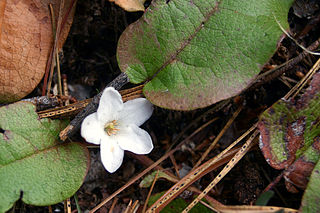
Epigaea repens, the mayflower, trailing arbutus, or ground laurel, is a low, spreading shrub in the family Ericaceae. It is found from Newfoundland to Florida, west to Kentucky and the Northwest Territories.
Wild Flowers Worth Knowing is a book published in 1917 as a result of an adaptation by Asa Don Dickinson of Neltje Blanchan's earlier work Nature's Garden (1900).

Nature's Garden: An Aid to Knowledge of our Wild Flowers and their Insect Visitors (1900), republished as Wild Flowers: An Aid to Knowledge of our Wild Flowers and their Insect Visitors (1901), is a book written by nature writer Neltje Blanchan and published by Doubleday, Page & Company. In order to aid the amateur botanist, it used color to classify flowers, noting that this made it easier for novices to identify specimens, and that insects also used color to identify plants. The book also explored the relationship between flowers and the insects that feed on their nectar, using rather anthropomorphic language, and discussed scientific questions of the time, such as Sprengel's theory that orchids produce no nectar. Her description of the flowers also referred to relevant poetry and folklore. Unlike her book Bird Neighbors, the photographs were taken directly from nature.

Bird Neighbors, published in 1897, was the first major work by nature writer Neltje Blanchan. The book combined scientific data with color illustrations, accessible language, and personal experience reflecting Blanchan's joy in nature. In his introduction, naturalist John Burroughs praised it as "reliable" as well as "written in a vivacious strain by a real bird lover."
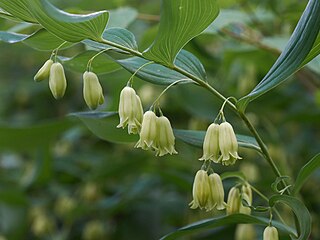
Polygonatum biflorum is an herbaceous flowering plant native to eastern and central North America. The plant is said to possess scars on the rhizome that resemble the ancient Hebrew seal of King Solomon. It is often confused with Solomon's plume, which has upright flowers.
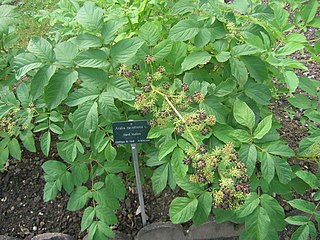
Aralia racemosa, with common names American spikenard, small spikenard, Indian root, spice berry, spignet, life-of-man, petty morel, is an ornamental plant in the family Araliaceae native to the United States and Canada. It is a herbaceous plant, about 1 to 2 m tall, which grows in shady areas. Its native range includes most of the eastern United States.
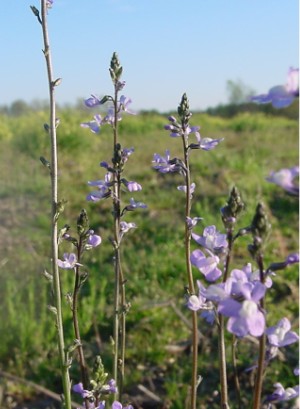
Nuttallanthus canadensis, the blue toadflax, Canada toadflax, or old-field toadflax, is a species of Nuttallanthus in the family Plantaginaceae, native to eastern North America from Ontario east to Nova Scotia and south to Texas and Florida.

Rhododendron viscosum, the swamp azalea, clammy azalea or swamp honeysuckle, is a species of flowering plant in the heath family Ericaceae. This deciduous shrub, growing to 2.5 m (8.2 ft) tall and broad, is native to the eastern United States. It has rounded matt green leaves. In early summer it produces funnel-shaped white flowers flushed pink. The flowers have prominent stamens and are strongly fragrant.

Veronicastrum virginicum, or Culver's root, is a species of flowering plant in the plantain family, Plantaginaceae. It is native to the eastern United States and south-eastern Canada. Growing to 200 cm (79 in) tall by 45 cm (18 in) broad, it is an erect herbaceous perennial with slender racemes of white or occasionally pink or purple flowers in summer.

Galearis spectabilis, commonly known as showy orchis or showy orchid, is an orchid species of the genus Galearis. It is native to eastern Canada and much of the eastern half of the United States.

Solidago flexicaulis, the broadleaved goldenrod, or zigzag goldenrod, is a North American species of herbaceous perennial plants in the family Asteraceae. It is native to the eastern and central parts of the United States and Canada, from Nova Scotia west to Ontario and the Dakotas, and south as far as Alabama and Louisiana. It grows in a variety of habitats including mesic upland forests, well drained floodplain forests, seepage swamp hummocks, and rocky woodlands.

Cuphea viscosissima, also known as blue waxweed, clammy cuphea or (ambiguously) as "tarweed", is an herbaceous plant in the loosestrife family. It native to the eastern United States, where it is most often found in open, rocky calcareous areas. It is the most common and widespread Cuphea in the U.S.
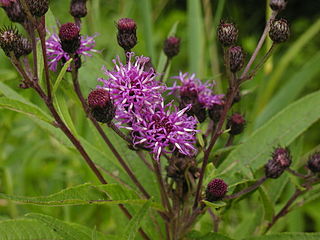
Vernonia noveboracensis, the New York ironweed or vein-leaf hawkweed, is a plant in the family Asteraceae. It is native to the eastern United States, from Florida to Massachusetts and west to Tennessee, Alabama, and West Virginia and to southern Ontario.
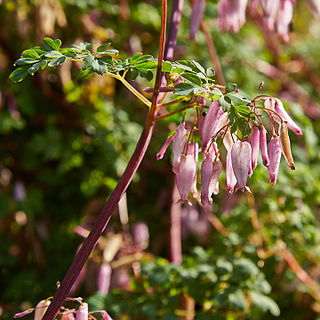
Adlumia fungosa is a species in the Papaveraceae that is commonly known as the Allegheny vine, climbing fumitory, or mountain fringe. It is a herbaceous, creeping, flowering plant and is closely related to the Fumitory genus, Fumaria.
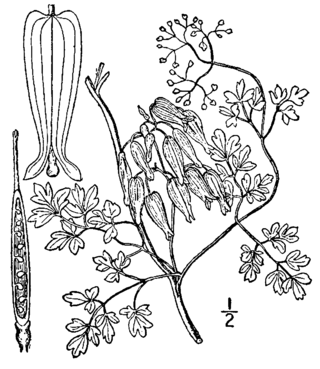
Adlumia is a genus of two species in the family Papaveraceae. The genus name derives from John Adlum (1759–1836), a surveyor, associate judge, plantsman and agriculturist who ran an 80 ha experimental farm in Georgetown, Washington, D.C. The genus was first described and published in Syst. Nat. Vol.2 on page 111 in 1821.



















